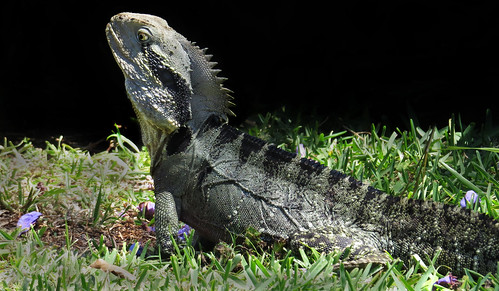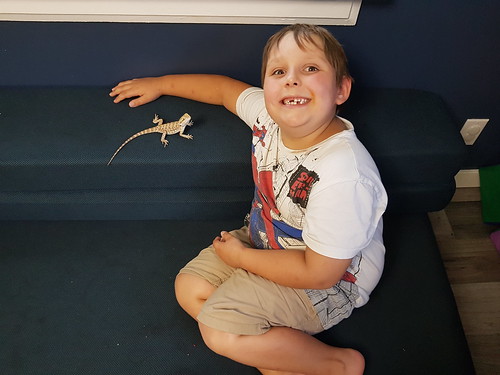Bearded dragons put their tails up for various reasons, mostly to communicate. When their tails are up, it means they’re feeling alert, excited, or threatened.
Here are 3 more reasons of why bearded dragons may put their tail up:
- Hunting: In the wild, bearded dragons stick their tails up when hunting because they are extremely alert.
- Alertness: Bearded dragons may curl up their tails when alert. This could happen when they move to an unfamiliar place, see something new in their enclosure, etc.
- Balancing: A bearded dragon lifting its tail up in a bath may be trying to balance itself. This is normal behavior for the species.
Reasons for Tail Raising
Bearded dragons are social creatures that use various forms of communication to interact with each other and their environment. One of the most common forms of communication is tail raising.
Bearded dragons raise their tails for several reasons, including defense mechanism against predators, communication with other bearded dragons, thermoregulation, and basking behavior.
Defense Mechanism Against Predators
When threatened by a predator or perceived danger, bearded dragons will raise their tails as a defense mechanism. This action is intended to make the bearded dragon appear larger and more intimidating to potential predators or threats.
The tail is often held high in the air and may even vibrate or wag back and forth. This behavior can deter predators from attacking or make them think twice before engaging in a fight.
Communication with Other Bearded Dragons
Bearded dragons also use tail raising as a form of communication with other members of their species. For example, males may raise their tails when courting a female during mating season.
The female will respond by flattening her body and presenting her hindquarters to signal receptiveness. Additionally, bearded dragons may raise their tails when asserting dominance over another member of their group.
Thermoregulation and Basking Behavior
In addition to defense mechanisms and social cues, bearded dragons also use tail raising for thermoregulation purposes. By raising their tails towards the sun or heat source, they are able to maximize exposure to warm temperatures while basking in the sun. This helps them maintain optimal body temperature levels which is essential for overall health and wellbeing.
The reasons for tail-raising in bearded dragons are multifunctional – used both as a means of communication between individuals as well as interaction with environmental factors such as sunlight temperature control. Understanding these behaviors can aid in the proper care and management of these magnificent creatures.
Behavioral Analysis
Bearded dragons are social animals and make use of their body language to communicate with each other. Tail raising is among the common behaviors that they exhibit to convey a message or reaction. Therefore, understanding tail posture and movement in these lizards is essential for pet owners to interpret their mood.
Observation of Tail Raising in Different Situations
Bearded dragons lift their tail in various situations. For instance, when basking under a heat source, they will raise their tails to regulate body temperature. In contrast, when threatened or scared, they puff up their beard and hold the tail high as a defensive mechanism against predators.
Moreover, during courtship displays or territorial defense, males usually raise their tails higher than females. On the other hand, when feeling relaxed or contented, bearded dragons tend to lower the tail and hold it still.
Discussion of Body Language Cues in Bearded Dragons
Understanding bearded dragon’s body language can help you create a strong bond with your pet. The head bobbing is among such cues that these reptiles use to communicate with humans and other bearded dragons.
Also, flattening of the body indicates submission or fear while arching of the back suggests aggression. A combination of different cues such as head-bobbing while raising the tail could indicate multiple messages such as dominance assertion or territorial defense.
Interpretation of Tail Position and Movement
Tail position and movement also provide crucial information about a bearded dragon’s mood. A low-hanging tail shows relaxation while twitching or whipping movements suggest distress or discomfort.
Moreover, if your pet raises its tail slowly but not high enough to form an S shape, it could mean curiosity towards something new in its surrounding environment.
Observing your bearded dragon’s behavior can help you understand what it is trying to communicate. A combination of different body language cues can help you interpret its mood and provide the most appropriate response or action.
Health Implications
Indication of Stress or Illness in Bearded Dragons
The position and movement of the tail can provide valuable insight into a bearded dragon’s overall health and well-being. A limp or lethargic tail may indicate that a bearded dragon is experiencing stress or illness.
In some cases, this could be due to environmental factors such as inappropriate temperature or lighting, inadequate nutrition, overcrowding with other reptiles, or insufficient hiding places in the enclosure.
In other cases, it could be due to an underlying medical condition such as metabolic bone disease, parasitic infections, respiratory infections, or kidney problems. As responsible pet owners, it is important to closely monitor our bearded dragons’ behavior and tail positioning for any signs of distress.
Importance of Monitoring Tail Behavior for Overall Health
Regular observation of a bearded dragon’s tail behavior can help pet owners identify potential health issues early on and take appropriate action.
By understanding our pets’ typical behaviors and habits, we can quickly recognize any changes that may indicate illness or discomfort.
For example, if a normally active and alert bearded dragon suddenly becomes lethargic and starts holding its tail down for extended periods of time, this could signal an underlying health problem that requires veterinary attention.
Additionally, monitoring tail behavior can help us ensure that our pets are comfortable and content in their environments by providing appropriate lighting, heating gradients, food variety and supplementation as well as adequate space to move around freely.
When it comes to caring for these fascinating creatures properly – including monitoring their tails – always consult with experts like veterinarians who specialize in reptile care so you are well-educated about your pet’s unique needs!
Conclusion
A Recap on the Importance of Understanding Bearded Dragon Behavior, Specifically Tail Raising
Bearded dragons are fascinating creatures that require proper care and attention. Their tail raising behavior is just one aspect of their complex communication and survival mechanisms. Understanding the reasons for tail raising can help you become a better caretaker and ensure your bearded dragon’s overall wellbeing.
Final Thoughts on the Significance and Complexity of These Fascinating Creatures
Bearded dragons are more than just pets; they are intelligent and social animals with unique personalities. The complexity of their behavior goes beyond simple instincts, as they exhibit clear communication cues with their body language.
By learning about these behaviors, we can create a stronger connection with our pets and provide them with a fulfilling life in captivity. Bearded dragons’ tail behavior is an important aspect of their survival instincts, communication methods, and overall health indicators.
By understanding why they raise their tails, you can improve your care techniques and enrich your relationship with these amazing creatures. Be sure to observe your bearded dragon’s body language closely to ensure they are happy and healthy in their environment.


